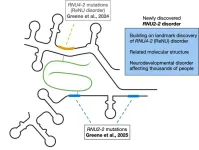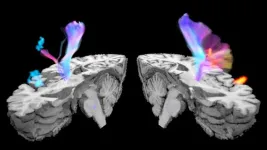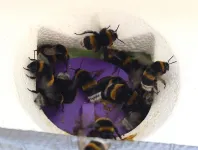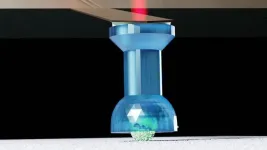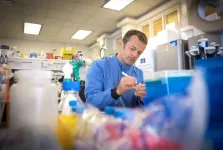(Press-News.org) Nursing poses major metabolic demands on mothers, to which they respond by eating more and saving energy to sustain milk production. There are significant hormonal changes during lactation, but how they lead to metabolic adaptations in nursing mothers remained unclear. In this study, which appeared in Nature Metabolism, leading researchers at Baylor College of Medicine and Pennington Biomedical Research Center uncovered a mechanism that connects prolactin, estrogen, the brain and metabolic adaptations during lactation.
“We worked with animal models to investigate how hormones and the brain work together to adapt to the metabolic demands nursing mothers face to sustain milk production,” said co-corresponding author Dr. Chunmei Wang, assistant professor of pediatrics at the USDA/ARS Children's Nutrition Research Center at Baylor.
“Normally, estrogen helps control appetite and increases the body's ability to burn fat, while prolactin does the opposite. During lactation, estrogen levels drop, and prolactin levels rise, leading to increased hunger and reduced fat-burning to compensate for extra energy demands posed by milk production and consumption,” said co-corresponding author Dr. Yanlin He, associate professor at Pennington Biomedical Research Center.
“We found that brain cells called estrogen receptor α (ERα) neurons in a small area of the hypothalamus are significantly less active during lactation,” said co-first author Dr. Meng Yu, postdoctoral associate in the Wang lab. “We showed that when ERα is deleted from these neurons, prolactin levels rise, and the animals increase their appetite and save energy by burning less fat. It was striking to see that just eliminating ERα in this tiny brain region was able to sustain such major metabolic consequences.”
“When ERα neurons were removed in non-lactating female mice, the animals showed high prolactin levels and lactation-like changes – eating more and burning less fat. Reactivating these neurons in lactating mice reduced these effects, showing their role in controlling metabolism,” He said.
“I am excited that we have discovered a novel mechanism for prolactin regulation,” Wang said. “We knew that prolactin is produced by pituitary cells, and estrogen can act on these cells to increase prolactin levels. Here we found a novel role of estrogen in regulating prolactin levels – it activates ERα neurons in the hypothalamus, which in turn inhibits prolactin levels during lactation. These findings have potential clinical applications.”
“The study sheds light on how the brain integrates hormonal signals to regulate energy balance, which could have broader implications for understanding hyperprolactinemia – high levels of prolactin in the blood – obesity, menopause and other conditions where prolactin or estrogen levels shift. This work opens exciting avenues for future research on neuroendocrine control of metabolism,” He said.
Other contributors to this work include co-first authors Bing Feng and Jonathan C. Bean, as well as Qianru Zhao, Yongjie Yang, Hailan Liu, Yongxiang Li, Benjamin P. Eappen, Hesong Liu, Longlong Tu, Kristine M. McDermott, Mengjie Wang, Xi Chen, Na Yin, Darah Ave Threat, Nathan Xu, Junying Han, Peiyu Gao, Yi Zhu, Darryl L. Hadsell, Yang He and Pingwen Xu. The authors are affiliated with one of the following institutions: Baylor College of Medicine, Pennington Biomedical Research Center or the University of Illinois at Chicago.
This work was supported by grants from the National Institutes of Health (R01DK129548, R56DK133776, R00DK107008, P30 DK020595, R01DK123098, R01 DK136627, K01DK119471), USDA/CRIS (3092-51000-062-04(B)S, a TCH-2023 Pediatric Pilot award, a fellowship award 3092-51000-056, American Heart Association awards (20POST35120600 and 20POST000204188) and a DOD Innovative Grant (W81XWH-20-1-0075).
###
END
How mothers adapt to the metabolic demands of nursing
2025-04-10
ELSE PRESS RELEASES FROM THIS DATE:
Caspian Sea decline threatens endangered seals, coastal communities and industry
2025-04-10
UNDER EMBARGO UNTIL THURSDAY 10 APRIL, 10AM LONDON TIME, 5AM EASTERN TIME.
Urgent action is needed to protect endangered species, human health and industry from the impacts of the Caspian Sea shrinking, research led by the University of Leeds has found.
Water levels in the Caspian Sea – the world’s largest landlocked water body – are getting lower, as hotter temperatures cause more water to evaporate than is flowing in. Even if global warming is limited to below 2°C, ...
Landmark study identifies new genetic cause of neurodevelopmental disorders, bringing long-awaited answers to families
2025-04-10
New York, NY [April 10, 2025]—A seminal study from researchers at the Icahn School of Medicine at Mount Sinai and their collaborators in the United Kingdom, Belgium, Spain, the Netherlands, and Iceland has uncovered a new genetic cause of neurodevelopmental disorders (NDDs). The discovery offers both closure and hope to potentially thousands of families worldwide who have long been searching for answers.
The study, published in the April 10 online issue of Nature Genetics [DOI: 10.1038/s41588-025-02159-5], reveals that mutations in a small, previously overlooked non-coding gene called RNU2-2 are responsible for relatively common NDD. Non-coding genes ...
Scientists create “metal detector” to hunt down tumors
2025-04-10
Researchers have created a “metal detector” algorithm called PRRDetect to hunt down vulnerable tumours, in a development that could one day revolutionise the treatment of cancer.
In a paper published today (Thursday 10th April) in Nature Genetics, scientists funded by Cancer Research UK and the National Institute for Health and Care Research (NIHR) analysed the full DNA sequence of 4,775 tumours from seven types of cancer. Based at the University of Cambridge and NIHR Cambridge Biomedical Research Centre, they used that data from Genomics England’s 100,000 Genomes ...
New USC study identifies key brain networks behind post-stroke urinary incontinence
2025-04-10
A new USC-led study using functional magnetic resonance imaging (fMRI) reveals the neural mechanisms that contribute to urinary incontinence, a common condition affecting stroke survivors that has a significant impact on their quality of life.
The research, just published in Stroke, was conducted by a multidisciplinary team of urologists, neurosurgeons, and imaging experts from the Keck School of Medicine of USC, Keck Medicine of USC, the Rancho Los Amigos National Rehabilitation Center, and the Shirley Ryan Ability Lab. The team discovered significant differences in brain activity during voluntary versus involuntary bladder contractions, presenting potential pathways for targeted therapies.
Urinary ...
Hidden potential in multiple disabilities
2025-04-10
Using eye-tracking — a technique for recording and analysing eye movements — a team from the University of Geneva (UNIGE) has shown that individuals with multiple disabilities can improve their social and emotional skills. Although these patients are often considered ‘‘untestable’’, nine young people have undergone personalised training over a period of one year, with promising results in terms of their ability to socialise. This work opens the way to new methods of assessment and support. It is published in Acta Psychologica.
Multiple disabilities involve a combination of severe intellectual and motor impairments, resulting in profound dependence. ...
How to protect bumblebee colonies safe from killer moths? Keep honeybee hives away from them
2025-04-10
Since the pandemic, we are very aware of the power of social distancing to protect against infectious disease. But can social distancing be effective if the infectious agent isn’t a virus or bacterium, but an insect powered by a brain and wings, and with the instinct to seek out new hosts?
Now, a study published to Frontiers in Bee Science has shown that physical distance does play a leading role in protecting bumblebees against a flying insect parasite, the bumblebee wax moth Aphomia sociella. The source of the potentially lethal infection was another species, namely nearby hives of domestic honeybees.
“Here we show that infestation with bumblebee wax moths is much greater ...
Rolling particles make suspensions more fluid
2025-04-10
Lacquers, paint, concrete—and even ketchup or orange juice: Suspensions are widespread in industry and everyday life. By a suspension, materials scientists mean a liquid in which tiny, insoluble solid particles are evenly distributed. If the concentration of particles in such a mixture is very high, phenomena can be observed that contradict our everyday understanding of a liquid. For example, these so-called non-Newtonian fluids suddenly become more viscous when a strong force acts upon them. For a brief moment, the liquid behaves like a solid.
This sudden thickening is caused by the particles present ...
Research fine tunes tools used to search for genetic causes of asthma
2025-04-10
Genome wide association studies (GWAS) have identified hundreds of genome regions containing thousands of genetic variants associated with asthma, but it’s still not clear which variants have an actual causal link to the disease. This “variant-to-function” gap is one of the biggest challenges to the usefulness of these genomic studies and has motivated researchers to develop new tools to make sense of GWAS results.
A new study by researchers from the University of Chicago combines genetic data and improved computational tools to look more closely ...
Meditation and critical thinking are the ‘key to meaningful AI use’
2025-04-10
People should learn to meditate and hone their critical thinking skills as AI becomes more integrated into daily lives, an expert suggests.
Digital strategy expert Giulio Toscani has spoken with 150 AI experts across 50 countries to understand the challenges and opportunities around human interactions with artificial intelligence.
He argues in his new book, Augmented: prAIority to Enhance Human Judgment through Data and AI, that as humans operate largely unconsciously by design, they are inclined toward immediacy and instant rewards, often overlooking potential ...
Studies shows new class of antibiotic is effective in tackling MRSA
2025-04-10
The development of new antibiotics to treat superbugs and other bacterial infections is a global priority, with the rate of infections that cannot be treated with current antibiotics rising and presenting one of the biggest threats to human health.
In line with that, new research has shown a daily dose of epidermicin NI01 – an antibiotic compound developed by University of Plymouth spinout company Amprologix – is as effective at removing Methicillin-resistant Staphylococcus aureus (MRSA) as the current standard of care.
The results were achieved through a robust skin MRSA infection model, and those behind the research say it justifies ...

